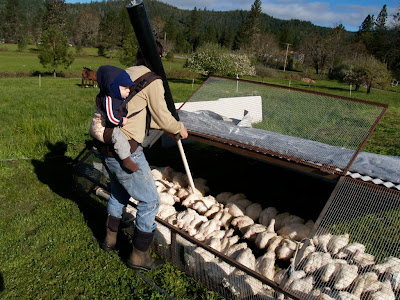I'm a little behind in my blogging. We went on a road trip and I wrote, but couldn't post, while we were gone. This entry would be dated May 9th.It's that time of year. Graduation cards are filling up card aisles at local stores. Yes, we're going to a couple graduation celebrations this year, but the most recent one here was anything but academic. The 6-week old chicks "graduated" to new quarters, specifically, we split the bunch into two, nearly-identical runs ("nearly", because Milan made several improvements to the design in building the second one).
You can see in the first image that the quarters were getting rather cozy. Chickens need each other, especially as chicks, to keep warm and for general camaraderie. But, they don't need this many friends all at once! Like all of us, they like to hang out in the sunshine (and sure wish we had more of it, lately!), so the "porch", seen here, is always the most crowded. When the runs are moved morning and evening, you can always tell where the sunny spots were: they're the thickest in chicken dung. This photo was also taken just before being fed, so they're crowding up to the front, eager for dinner.

The new run spot is down in what we call "The Girls' Field", as its where our two mares lived for quite a while. It's the field closest to the house that's not "lawn" or landscaping (... kind of. Those categories all seem to blur together here, depending on what's going on. For example, this Spring we paddocked the horses on the "lawn", moving the paddock every one or two days, because that's where the best feed was with the least likelihood of damaging the incoming grass crop). The chickens had to be moved down the lane, across a small bridge, and out a ways into the field, as the ground along the fence was too bumpy. The run needs flat, smooth ground. This allows it to sit pretty snugly on the ground and keep out small critters (mostly weasels). Milan got the new run all set up before starting to catch chickens out of the old run, including running 500+ feet of white poly hose from the nearest underground water box. The hose is white (poly hose is often black) to keep it from heating up the water, which flows into the automatic watering system.
The new run also has a system of removable plexi-glass panels for rain, snow and wind protection. You can see it also only has the one, long feed trough. The trough is set up to be raised and lowered according to the birds' height (see the photo with Jack grabbing at a wire with stoppers on it). It's made out of a 4" PVC pipe with 90-degree cut out from center (so cut at about 3/4 instead of in half) to hold as much feed as possible while still giving the chickens ample access. The 10-minute criterion (mentioned in
"The Feeding Frenzy") still applies.


Next up, move the chickens! Milan caught up 23 at a time out of the run while I opened and closed the door on our large dog kennel and made sure Jack didn't get into trouble (I spend a lot of time doing the latter!). It was just the two of us, so we didn't get pictures of the actual carrying -- Milan on one side of the kennel with Jack on his shoulders, and me on the other, hauling the white birds down the hill. I was surprised at how heavy 23 of them are in one place!

And as usual, Jack wanted to be in the thick of everything.
It took some doing getting the second run, which still had 46 chickens in it, down the hill. It was quite a long walk for the birds, not to mention quite a job for Milan, who provided all the muscle in the operation. I was in charge of keeping the birds moving so that none of them would slip out the back or taken out by the moving run. We took lots of breaks and only moved a few feet at a time, for both the birds and Milan, but what we didn't think of animals' fear of weird, new surfaces, like gravel or a wooden bridge! The chickens have grown up on grass, so when we had to pull the run off the lawn and onto the drive, they all bunched up and tried to stay on the grass. Convincing them they could walk on the gravel just fine was a little comical and frustrating. Same deal with the transition from gravel to wooden bridge! Ah, the things we're learning!
We did finally get the second run in place next to the first. Milan connected the watering systems, which most of the slightly stressed and thirsty birds immediately appreciated, and gave them a little extra helping of food for the energy expended in the whole affair (also appreciated!).
Cash, our big, white Pyrenees cross, will be staked out at night with the chickens to keep any wild creatures from getting too curious.















